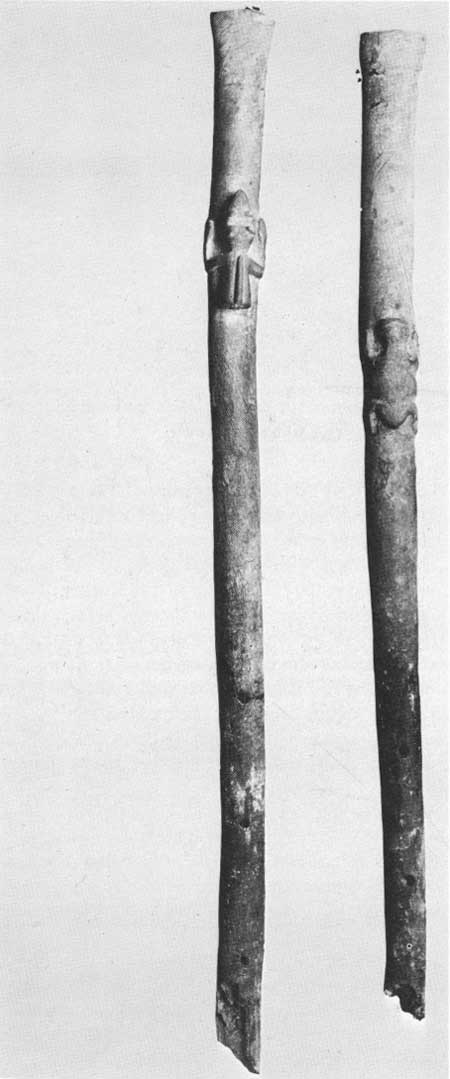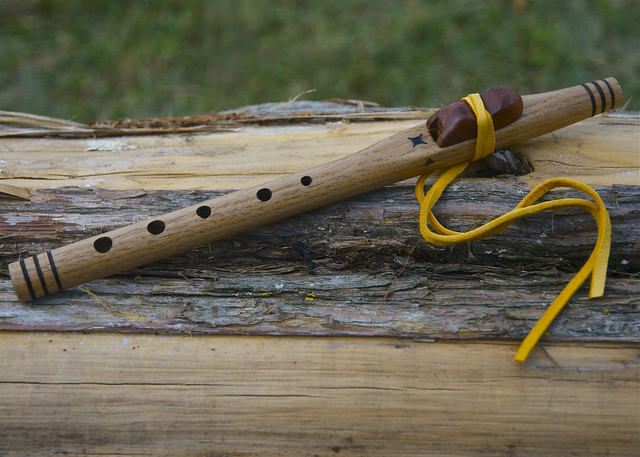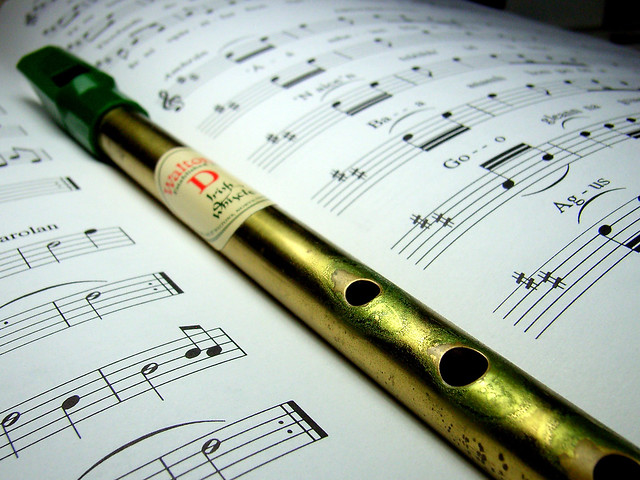 |
| Shakuhachi Flute - Music-Instruments of the World |
Showing posts with label Native Flutes. Show all posts
Showing posts with label Native Flutes. Show all posts
Tuesday, December 4, 2018
Monday, September 10, 2018
Playing Duets With NATIVE AMERICAN and ANASAZI FLUTES
 |
Duet playing between Native American flute players is a fairly simple task. The players usually select the key in which they choose to perform, and take turns in listening and playing. As long as the flutes are tuned to the same pitch, the compatibility of the instruments will be pleasing. Pairing an Anasazi-style flute with a Native American flute (NAF) presents a different problem due to the way keys are designated for each kind of flute. The root note designation for Anasazi-style flutes denotes the beginning of a major pentatonic scale. Common keys for Anasazi flutes are A, G# (or Ab), and some higher pitched versions in C and D.
Unlike almost any other Western key-tuned flute, the NAF is named by a minor key rather than the major, because of the pentatonic minor scale structure of the NAF. Flute players fill in their collections by acquiring instruments in various root notes (F#, G, A, etc.), and that root note designation refers to the minor key of that note. For example, the NAF in A is really A minor, no sharps or flats. The major key with no sharps or flats is C, and with the right fingering the NAF in A minor can also play the major C scale (also called mode 2 for the NAF).
The Anasazi scale is based on a pentatonic major scale based on the lowest note of the flute. This distinction is important because a NAF flute in A (minor), no sharps or flats, is not compatible with an Anasazi flute in A (major), 3 sharps. And while it's worth noting that the Anasazi flute can play in a minor mode, a greater number of compatible notes between the two kinds of flutes are available if you use flutes with the same number of sharps or flats in their scale structure.
In music theory, each set of sharps and/or flats in a major key have its minor key complement (called a relative minor). The musical distance is a minor 3rd apart. If you pair a NAF with an Anasazi flute, use this as a guide:
Anasazi A with NAF F#m (3 sharps)
Anasazi G# (Ab) NAF Fm (4 flats)
Anasazi C with NAF Am (no sharps or flats)
Anasazi D with NAF Bm (2 sharps)
Take a listen to Welcome Dance and Two Hearts in the September 18 post at http://www.anasazidream.com. The overdubbed recording is played with an F#m NAF with an A Anasazi Dream flute. Because both instruments share the same key signature, the pieces hold together musically.
Article Directory: EzineArticles |
Tuesday, June 19, 2018
Tuesday, February 13, 2018
Soothing Music: The NATIVE AMERICAN FLUTE
 |
| Photo by wplynn |
Mothers of small children often find that Native American flute music is very soothing for their babies. It seems to have a tranquil and calming effect on children. Songs played on the Native American flute can be introduced during naptime and before bedtime to calm children down. The music often puts children to sleep within just a few minutes. Experts have also recommended Native American flute music to families with small babies that have a hard time getting to sleep.
This music also represents an excellent tool for calming down a baby in situations where there may be difficult transitions for such young children, such as when many visitors come to the home. It is often difficult for small babies to adjust to the confusion and noise created by a large number of people at special occasions, and playing Native American flute music can help to calm a baby down in these circumstances.
The music of the Native American flute is very soft, and it creates a wonderful, soothing background for many situations. It is just the sound of keeping babies calm when there are a lot of people in the environment. Babies seem to focus on the flute sounds instead of on the loud noises generated by crowds. Having flute music playing in a room makes it easier for them to adjust to visitors.
Of course, adults will also enjoy the music of the Native American flute. It is easy to find interesting and unique Native American flute music on the Internet since many online stores offer selections of alternative music. It is also possible to purchase Native American flutes and sheet music. Several vendors offer musical compositions for the flute, and they sell Native American flutes as well.
Native American flute music is an excellent way to learn about and enjoy the special features of Native American culture. And since songs are often linked to memories, this music offers a good way to preserve the memory of special times.
Tuesday, October 10, 2017
CELTIC MUSIC - The Tin Whistle
 |
Photo by chidorian  |
The tin whistle is a simple instrument -- and it's simple to play, and simple to play easy tunes. But -- it's not simple to master! The instrument may be cheap, but you'll have to pay for mastery ... by practicing! The haunting whistle tunes from the movie "Titanic" illustrate the deep soul found in this instrument.
This instrument is commonly made from metal (usually brass) with a molded whistle mouthpiece. By playing it open (not covering any of the six fingerholes), then by covering each fingerhole in turn, you can play the 7 notes in a diatonic (a simple Do-Re-Mi scale -- essentially the white keys on a piano) scale. Blow a little bit harder and you'll play the same note, but an octave higher. While it is a diatonic instrument, you can achieve sharps and flats by half-covering fingerholes.
Since there are essentially only two open notes -- a note, then the note an octave higher when you blow harder -- each tin whistle is said to represent a certain Key signature. For instance, if the open note sounds a "D", then the whistle is considered to be in the key of D. Many players carry a small set of whistles in the most commonly used keys.
Some people don't realize you can actually tune a tin whistle! You do so by sliding the metal barrel of the whistle in and out of the mouthpiece head. Some whistles have the head glues securely to the barrel. You can usually loosen the glue by holding the joined portion under hot running water. Don't use boiling water -- this may melt the plastic whistle head!
Key signatures commonly found in Celtic Music are "D Major" and "G Major". By default, all tin whistles are in a Major key (since they play a diatonic scale). However, if you begin your scale with all the fingerholes covered (instead of all fingerholes open), then you're beginning one step higher than a diatonic scale -- which results in a minor key signature! For instance, a tin whistle in "D" can play in E Minor if you begin your scale by covering all the fingerholes. Interestingly enough, the chord sequence "E Minor" and "D Major" is commonly found in Celtic Music. (This is the same chord sequence used in "What Would You Do with A Drunken Sailor".) A whistle in "G Major" could easily play in A Minor (A Minor and G being another commonly found chord sequence).
Joey Robichaux operates Celtic Sheet Music at http://www.celtic-sheet-music.com where whistle players can freely download over 3,000 Celtic fiddle tunes!
Article Directory: EzineArticles
|
Saturday, August 12, 2017
Saturday, July 1, 2017
The Mythical Sounds of the PAN FLUTE
The pan flute is an instrument that consists of ten or more pipes, which differ in length, that are closed tube. The tubes are placed in a row, from the longest tube to the shortest. Each length will then produce a different note, depending on its length. It is most often viewed as an old folk instrument and it is what preceded the harmonica and the pipe organ. It is believed that the different lengths of the tubes in the pan flute were the inspiration for the pipe organ. While original pan flutes were generally made from reed or bamboo, most pan flutes today are made out of metal, plastic and wood.
 |
| Pan Flute - Photo by Horia Varlan |
As the ends of the pan flute are stopped, the flute is not played by the musician blowing air directly into the tubes. Instead, the pan flute is played by the musician blowing air across the opening, much the same way as other flutes are played. While the instrument appears fairly simple in its design and limited in the sounds it can play, the musician playing the pan flute can actually play a wide range of musical notes that can make some pleasant music.
In fact, an experienced player can play both sharp and flat notes by tilting the flute a certain way and by how they blow the air across the mouth of each tube. Even more experienced musicians can have such a good handle on the pan flute that they can play a scale in any key and creating vibratos is little trouble for them as well.
While the pan flute has been around for a very long time, and it didn't appear to be overly popular in modern times, the pan flute really began to come back in the late 1900s, especially after a Gheorghe Zamfir, a Romanian musician, recorded many albums, toured and became well-known for his pan flute music.
Today, many people have chosen to play the pan flute and have continued to play for their love and enjoyment of the music and the instrument. In fact, there are other very well-known musicians who have used the pan flute in some of their music, including Aerosmith and The Beatles. It has also become quite popular in New Age music, perhaps for its light and soothing tone.
It might not be the first instrument that many will immediately choose when deciding on an instrument to play, though many who have heard the pan flute, and enjoy the genre it is typically played in, will choose the instrument. It can be a rewarding instrument to play and one that does not create a lot of noise when trying to practice at home. It is a quieter instrument, though its sound can attract attention because of its clear and soothing tone. It is a pleasant instrument to play, even if not for a career in music. There are many people out there who have chosen to learn the pan flute as a hobby because they enjoy the sound and they like to play on their free time for fun.
Article Directory: EzineArticles |
Thursday, May 11, 2017
The ANASAZI FLUTE and the NATIVE AMERICAN FLUTE
Authentic Native American FLute by James Starkey, aka Wanbli WiWohpe
(Photo credit: Wikipedia)
The current popularity of the replicas of the ancient Anasazi flute among members of the Native American flute community present some interesting challenges for the Native American flute (NAF) enthusiast. The main difference comes from the nature of sound production of the different flutes. Traditional NAFs owe their mouthpiece structure to the European recorder or penny whistle due to the fipple which splits the air column creating the sound.
As the NAF developed, a two-chamber system with a small air channel directing the airflow became the standard. The Anasazi flute replicas are examples of a much earlier, less technical system of using a mouth-guided airflow, or embouchure, as the means of sound production.
The early NAFs scale and tuning systems varied. There was a biometric method based upon boring holes corresponding to distances of various points of the player's hands, as well some tunings much like the major scale of recorders and penny whistles. Sometime in the 1950s-70s the standardization of the pentatonic scale became the familiar sound that has attracted people to the flute. The relative ease of sound production and pleasing sound of the pentatonic scale ensures quick success for the musician and non-musician alike. In contrast, the Anasazi-style flutes require that a tone be created by training the mouth muscles to direct the sound across the front edge of the top of the flute. This difference is at first difficult for many people since sound is not automatically produced by simple blowing, but is produced much like blowing across a soda bottle. A bit of muscle memory and trial and error (and a significant amount of practice) is necessary before a consistent sound can be obtained.
The other difference between the two flutes is that the basic scale pattern of the Anasazi flute is a pentatonic major scale. That is somewhat of a simplification because by utilizing other fingerings a more plaintive, minor sound can also be produced, but the main harmonic basis of the flute is a pentatonic major. Although the two flutes are different in construction and playing technique, the two can indeed be played together as will be discussed in a future article.
Article Directory: EzineArticles |
Subscribe to:
Comments (Atom)



